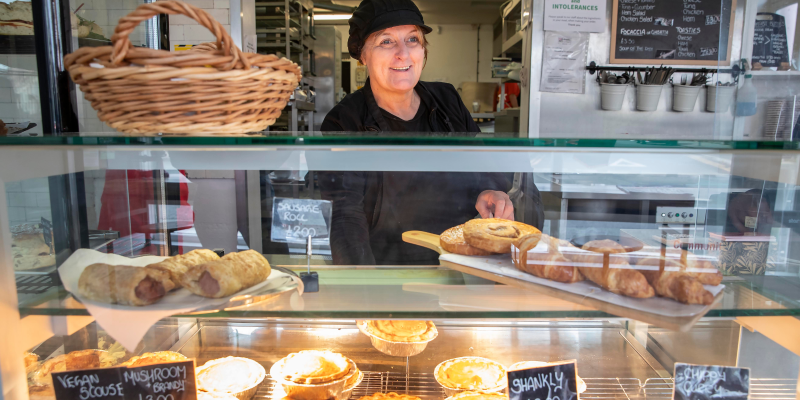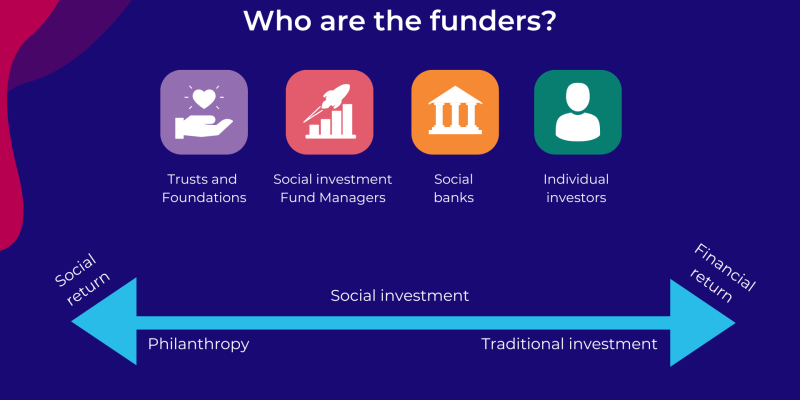Annie Constable, Digital Project Manager at Good Finance, provides a detailed guide to all things social investment, including what it is, how it works, how much it costs and more, as well as key tools and resources to help charities and social enterprises to navigate the space.
In 2023, investment into UK social impact exceeded £9 billion, despite the turbulent and uncertain economic circumstances (or economic gloom) of recent years. Our own data suggests more charities and social enterprises are exploring the use of repayable finance to diversify their income than ever before, but it’s difficult for organisations to navigate such a complex and fast-moving space.
This guide aims to act as a good starting point for any charity or social enterprise looking to better understand social investment, what it is, how it works and crucially whether it could help your organisation to deliver more social impact.
What is social investment?
‘Social investment is the use of repayable finance to help an organisation achieve a social purpose.’
That’s not a definitive definition, but it’s the one we like and use. Social purpose organisations use the capital provided by social investment as a tool to increase the impact they have on society. This could be in the form of growing their business to cater for more people or buying an asset to escape rising and uncertain rental costs.
It doesn’t matter if your in the highlands of Scotland or Lands End in Cornwall – social investment plays an important role in helping organisations to tackle some of the key social problems facing the UK in 2024 and beyond.
We could go on, but perhaps instead grab a cuppa and watch this two-minute animation explainer, for more context on how this works in practice.
It’s important to see social investment as a part of your wider financial toolkit rather than the be all and end all in achieving your social impact. Trading, donations, fundraising, contracts, grants and other sources of mainstream finance are other elements to consider, and you may wish to use all or a combination of these depending on your organisation.
Social investment is NOT a direct, like-for-like replacement for grants – rather they would sit alongside each other as key tools in your toolbox.
Key considerations for organisations exploring social investment
The process of social investment is by no means quick or easy and would actually require a fair amount of investment in time from people in your organisation. Before you jump in and waste precious time exploring something that may not be able to solve all your problems, make sure you’re aware of these three key considerations…
1. Purpose – what do you need the money for?
To buy an asset?
Perhaps you’re currently renting a shop space on a high street, but it’s too small to meet demand of the service users and costs have increased threefold. Using social investment to purchase the building would not only provide security and a more permanent base for your organisation, but it will also ensure monthly repayments are or predictable and pre-determined.
In some cases, this can actually save money on a monthly outgoings basis, particularly if you can secure a longer loan duration with your investor than what would be typical of a mortgage provider.
An example of an organisation using repayable finance to purchase an asset is Homebaked Bakery in Liverpool. They purchased a dedicated catering unit with specialised equipment which enabled them to increase their pie production capabilities threefold, meaning they could meet the ever-increasing demand for match day pies at their base, opposite Anfield football stadium in Liverpool. Read their full case study to understand more about their experiences with social investment.

To maintain cash flow?
Perhaps you’ve been around for a few years now, proven resilience throughout Covid-19, the Cost of Living crisis and continue to generate a positive social impact for your community. However, you need capital to deliver a new service that would further increase the impact you deliver, but not necessarily provide the financial returns to sustain itself.
Sometimes this can be as simple as the dates in which your bills and outgoings are scheduled means you are falling just short on a monthly basis of affording these costs. Social investment can be used to bridge that gap and helps you to avoid expensive, emergency capital in the form of overdrafts.
An good example of an organisation using social investment to help with cashflow is Café van Gogh, a Brixton-based restaurant that provides employment and training opportunities for people with additional needs. They sought social investment to help them review their menu, removing unprofitable offerings like their breakfast menu, enabling them to return to financial stability.
Read the full story via their case study.

To kickstart your business?
For many, getting started can be one of the biggest challenges in turning your fantastic idea into a reality. “Start-ups” are seen as high-risk in the eyes of mainstream finance and without a track record it’s difficult to convince people to invest their capital in something that may or may not deliver the financial returns they’re looking for.
Fortunately, social investors consider both financial return and the social value return, so are more likely to accept the ‘high-risk, low-return’ reality for many start-ups in the social sector. You may want to secure capital to design your product or service, for sales and marketing, investment in systems, staffing or other areas of your business that needs further development to achieve success.
A great example of an organisation that used social investment to kickstart their business is Circus Strong, a community organisation that provides aerial circus and fitness classes, especially welcoming the LGBTQ+ community and individuals experiencing poor mental health. They used the capital to secure a venue and purchase industry standard equipment to be able to provide the space for the communities they serve.
Read the full case study, or hear more about Holly and Circus Strong via this podcast episode.

To grow and innovate?
You’re confident in your social business, you’ve been there, done that and got the ‘proof of concept’ t-shirt, and now it’s time to scale your venture, increasing the impact you’re able to create for the communities you serve.
This could involve increasing your capacity so you can grow your base of customers, exploring a wider range of products or services on offer or venturing into a new area geographically, and you’ll need capital to help you achieve these plans for growth. Presumably, you’d already have a revenue-generating arm of the business which makes this proposition less risky in the eyes of investors.
A good example of this is Câr-Y-Môr in Wales, a community-owned business using regenerative ocean farming for the well-being of the local community. They sought social investment to extend their services and build a seaweed processing plant, which will help them to achieve some of their environmental objectives. Read their full case study, here.

2. Repayment
This one’s really quite simple. Do you have an income stream with a surplus that can cover the interest of the loan?
It doesn’t take an economic mastermind to realise that if you’re not revenue-generating, social investment is probably not the best way to support your organisation. You need to be able to pay back the money, so investors can sustain themselves and lend to other organisations like yours in the future.
This could come from a range of things including payment for goods or services, government contracts, rental income, membership fees, even some donations or fundraising. Are you confident in your surplus and the affordability of the loan for your organisation?
3. Impact
What social impact will you create? This is what perhaps differentiates social investors from the mainstream…
A social investor will need to know the impact you’re going to create, so you will need to tell your story, who’s going to benefit, what outcomes you’ll create and put very simply…what difference will the money that you’re being lent make in the long run?
Check out our measuring social impact page for more tools, resources and information, or this handy blog in telling your impact story.
There’s lots more to think about, including the amount you need, your business model and plan, the implication of your legal structure and the time, resource and people needed to navigate your way through the social investment process.
This video shares a little more insight into the reality of social investment…
What are the different types of social investment available?
When it comes to social investment, there are two main types of products available.
Debt, which is essentially borrowing money and paying it back with interest over a period of time, and equity, which is when an organisation sells shares to an investor and they then own a percentage of the business.
Beyond that, there’s no shortage of specific investment products that might be applicable, depending on a number of factors. From blended finance (loan mixed with grant) to quasi-equity (payment based on results), from secured (borrowing secured against an asset) to unsecured (borrowing without securing to an asset) and Crowdfunding (investment raised by many online) to Community Shares (equity of a community-owned business) – there’s no shortage of products available, and it’s well worth putting in some time to research which is most suitable for your organisation.
Who are the funders?
There are also two main ways of getting social investment. From an organisation, including specialist Social Investors, Social Banks and Trusts and Foundations and from an individual, including Crowdfunding, Community Shares and Angel Investors.
If you think of finance as a scale, with traditional investment prioritising financial return at one end and philanthropic capital prioritising outcomes and social value at the other, social investors tend to sit somewhere in the middle.

How much does it cost?
The million-pound question! Unfortunately, there’s no-size-fits-all answer. Investors have different appetites for loss and return, and this will determine how much capital is available, and what cost of capital (interest) rate they’ll need to charge for the investment.
You may hear people talking about ‘patient’ capital, and that’s because loan duration can actually affect the affordability of the loan in a similar way to the interest rate you’re being offered.
For example, borrowing £20,000 over 5 years with 5% interest would cost around £22,645.48 in total, with monthly repayments of £377.42. Borrowing the same amount, with the same interest rate but over 10 years, would mean a higher total cost of £25,455.72, but much lower monthly repayments of £212.13.
To learn more about cost of capital, watch our 2-minute explainer and check out our Cost of Capital Calculator to compare loan terms for an estimate on monthly and total repayment costs.
3 steps for what’s next…
Congratulations - you’ve made it this far down the blog and I’d say it’s safe to assume you have an interest in exploring social investment in more detail….and we’ve got good news!
At Good Finance, our mission is to help Charities & Social Enterprises to navigate the world of social investment and, as such, we have no shortage of free tools and resources available on our website that you can access right now.
Step #1 – Is It Right For You?
Our Is It Right For Us tool takes just two-minutes to complete and will help you to determine whether or not social investment is an avenue worth exploring for your organisation. If it is, it’ll provide suggestions for what to do next and if it’s not, it’ll signpost to some resources that might help you to prepare for social investment.
Step #2 – Measure your Social Impact
The Outcomes Matrix is a fantastic starting point for planning and measuring the social impact you create in terms of Outcomes. Covering measures for nine different outcome areas and four lenses for service users, there’s just four steps to go through before downloading your own unique matrix, which can be used to communicate your impact with social investors and other key stakeholders.
Step #3 – Find your Social Investor Match
Use our Fundmapper Tool to start searching and contacting social investors that may want to use their capital to support your organisation’s vision and mission. You can filter your search by location, social issue, amount required and type to ensure you find the social investors that are most suitable and aligned with your organisation.
Making the most of Good Finance…
There’s also a number of case studies showcasing social investment in action, blogs and podcasts exploring various topics on social investment and any number of events featuring ‘Hear from a Peer’ speakers available to watch on demand.
At Good Finance, we also deliver a range of programmes for organisations looking to further their knowledge and increase their confidence in talking about social investment. These are for everyone, but particularly helpful for anyone working in infrastructure organisations who would like to upskill their knowledge to provide tailored support for their members. Check out Social Investment Unpicked for more information on cohort start dates, logistics, course content and to register your interest.
Sign up to our newsletter to receive the latest news, views and updates from the world of social investment and make sure you’re following us on X (formerly Twitter) and LinkedIn.
…and finally, one top tip to leave you with. Add the Jargon Buster as a bookmark on your web browser of choice to help you bust sector jargon, complex terms and pesky acronyms that can be found in every walk of life, but seem to be particularly prevalent in social investment.
Thanks so much for reading our blog! If you have any feedback or further questions based on the above, please don’t hesitate to contact aconstable@goodfinance.org.uk. We hope it’s provided more information about social investment and how it can drive positive social change in the UK.
